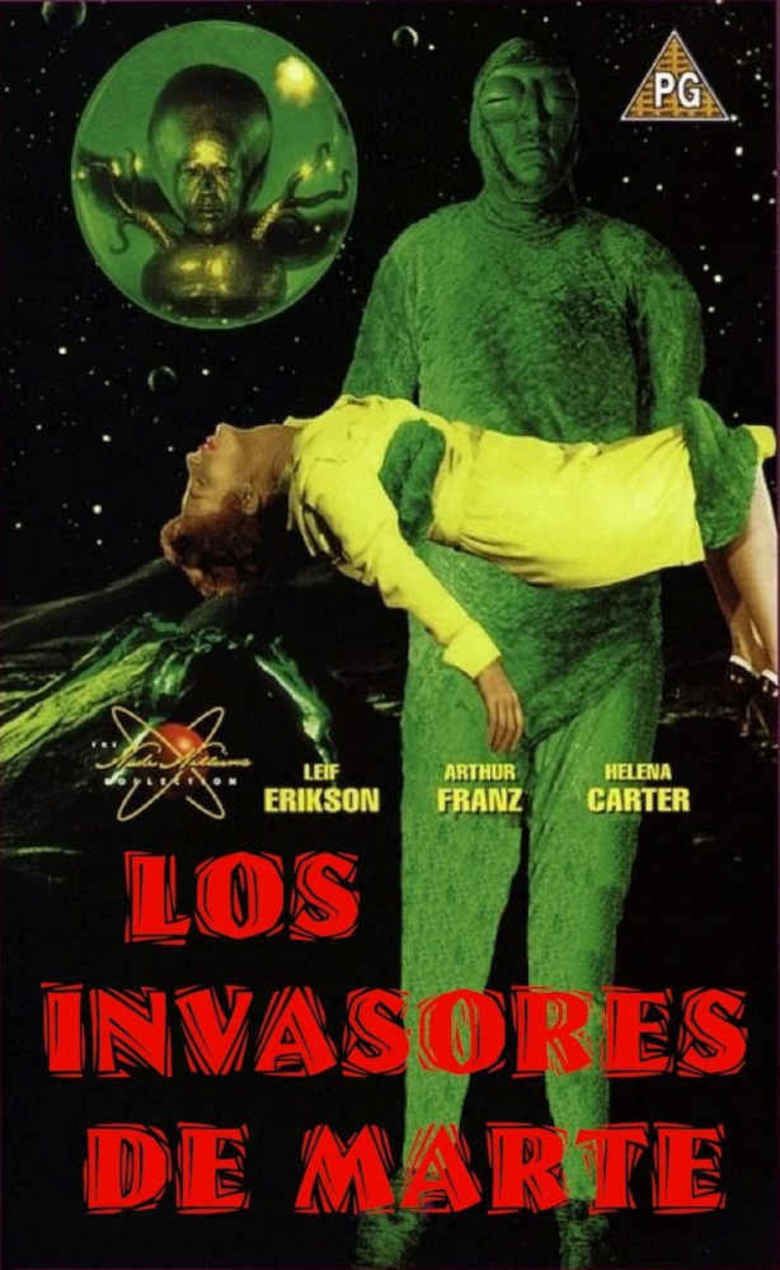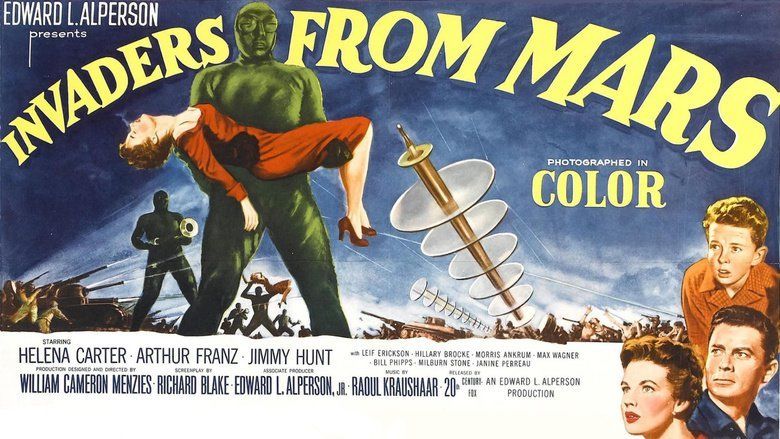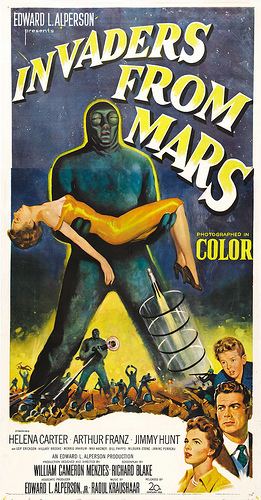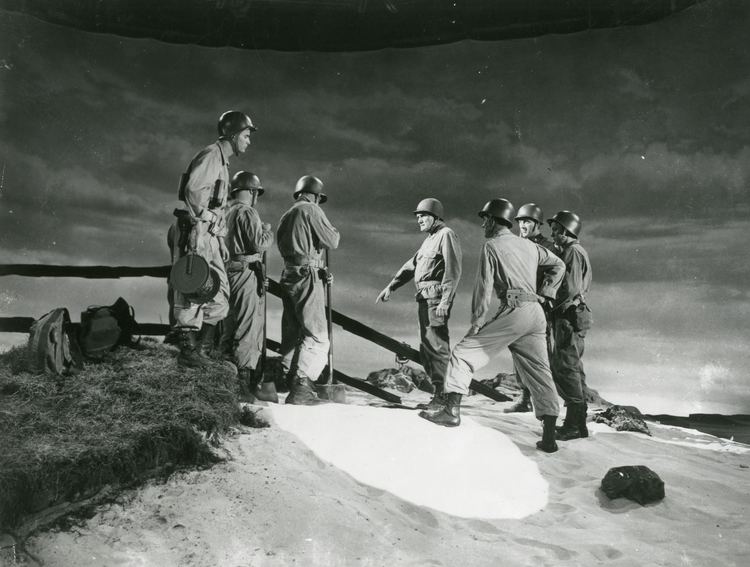Invaders from Mars (1953 film)
6.8 /10 1 Votes
Genre Horror, Sci-Fi Language English | 6.6/10 IMDb Budget 290,000 USD Duration Country United States | |||||||||||||||||||||||||||||||||
 | ||||||||||||||||||||||||||||||||||
Writer Richard Blake (screenplay) Release date April 22, 1953 (1953-04-22) Cast (Dr. Pat Blake, MD), (Dr. Kelston - astronomer / Narrator), (David Maclean), (Mr. George MacLean), (Mrs. Mary MacLean), (Col. Fielding) Similar movies Edge of Tomorrow , Independence Day , Close Encounters of the Third Kind , Avatar , Transformers: Age of Extinction , The Avengers Tagline NATURAL or SUPERNATURAL? | ||||||||||||||||||||||||||||||||||
Invaders from mars 1986 movie trailer
Invaders from Mars is a 1953 independently made American SuperCinecolor science fiction film, produced by Edward L. Alperson Jr., directed by William Cameron Menzies, that stars Jimmy Hunt, Helena Carter, Arthur Franz, Morris Ankrum, Leif Erickson, and Hillary Brooke. The film was distributed by Twentieth Century-Fox Film Corp.
Contents
- Invaders from mars 1986 movie trailer
- Invaders from mars 1953 trailer
- Plot
- Production
- Music
- Visual design
- Special effects
- British release
- British ending
- Critical reception
- Influence
- Remake
- Invaders from mars 1953 movie trailer
- References

Awakened during a thunderstorm, youngster David MacClean witnesses a brightly lit flying saucer disappear underground in the large sand pit behind his home. When his father investigates, he returns a changed man; soon David's mother, a young neighbor girl, and others begin to act in the same way. Begging the police for help, David's panicked story is heard by Dr. Pat Blake, who takes him to astronomer Dr. Stuart Kelston. David soon convinces Kelston, who comes to believe this is an invading vanguard from Mars.

Invaders from Mars was developed from a scenario by Richard Blake and based on a story treatment by John Tucker Battle, who was inspired by a dream recounted to him by his wife. The film was rushed into production to show in theaters before George Pal's War of the Worlds (also 1953), thus Invaders from Mars became the first feature film to show aliens and their spacecraft in color.

Invaders from mars 1953 trailer
Plot

Late one night, youngster David MacLean (Jimmy Hunt) is awakened by a loud thunderstorm. From his bedroom window, he sees a large flying saucer descend and disappear into the sandpit area behind his home. After rushing to tell his parents, his scientist father (Leif Erickson) goes to investigate David's claim. When his father returns much later in the morning, David notices an unusual red puncture along the hairline on the back of his father's neck; his father is now behaving in a cold and hostile manner. David soon begins to realize something is very wrong: he notices certain townsfolk are acting in exactly the same way. Through his telescope, David sees child neighbor Kathy Wilson suddenly disappear underground while walking in the sandpit. David flees to the police station for help and is eventually placed under the protection of health-department physician Dr. Pat Blake (Helena Carter), who slowly begins to believe his crazy story.

With the help of local astronomer Dr. Stuart Kelston (Arthur Franz) and Dr. Blake, David soon realizes the flying saucer is likely the vanguard of an invasion from the planet Mars, now in close orbital proximity to Earth. Dr. Kelston contacts the U.S. Army and convinces them to immediately investigate: An important government rocket research plant is located nearby. In short order, the Pentagon assembles troops and tanks under the command of Colonel Fielding (Morris Ankrum). An alien sabotage plot at the plant is soon uncovered, leading back to the sandpit, and the army surrounds the saucer landing site.

Standing well away from the army search, Dr. Blake and young David are suddenly sucked underground. They are captured by two tall, slit-eyed green humanoids and taken via tunnels to the flying saucer. Army troops locate and blow open an entrance to the tunnels, and Colonel Fielding and a small detachment make their way to the saucer entrance. Inside, they confront the Martian mastermind: It has a giant green head with a humanoid face atop a small, green partial torso with several green arm-tentacles, and is encased in a transparent sphere. The Martian is served by the tall, green, silent, synthetic mutants. Under their master's mental commands, the mute humanoids have implanted mind-control crystals at the base of the skull of their kidnapped victims, forcing them to attempt sabotage at an atomic rocket project being built at a military plant near the town; if they are caught, the mind control devices explode, causing a fatal cerebral hemorrhage. The troops and Colonel Fielding, with Dr. Blake and David in tow, open fire on the pursuing mutants as their group escapes the saucer. After a short running battle in the tunnels, they return to the surface. Orders are given for everyone to quickly leave the area: Fielding's troops have planted timed explosive charges aboard the saucer.

In an extended montage, David runs downhill away from the sandpit. As he does so, flashbacks of the film's important events are superimposed over a close-up of his face, including scenes played backwards for surreal effect. These are inter-cut with alternating shots of artillery opening fire on the sandpit or close-ups on the ticking timer slowly approaching zero.
Following a large explosion, David is suddenly back in his bed. Thunder and lighting are heard again. He runs into his parents' bedroom, confused and frightened; they reassure him that he was just having a bad dream, telling him to go back to sleep. Having returned to his bed, more wind and loud thunder is heard. David then climbs out of bed again, goes to his window, and witnesses the very same flying saucer of his dream slowly descending into the sandpit; the screen then holds on young David, who says "Gee whizz", and then dissolves to the film's "The End" title card, as the film's ethereal music reaches its crescendo in coda with the final fade-out.
Production

Invaders from Mars recounts its story from the point of view of an older child in an adult world heading into crisis.
Music

The production makes use of a unique outre music score that consists of an ethereal, rhythmically wavering tonal composition sung in unison by a choir. It is used as both a sound effect and as the scenic score associated with the Martians. As the film's "The End" title card and end credits are displayed, the ethereal music underscores an unspoken question that only each viewer can answer: is young David still asleep, trapped in a recurring nightmare, or was his bad dream a premonition of this now real event? The score is credited to Raoul Kraushaar, but Thomas Hischak's Encyclopedia of Film Composers notes that most of the score is now believed to be the work of frequent Republic composer Mort Glickman.
Visual design
An Eastmancolor camera negative was used for principal photography, with vivid SuperCinecolor prints struck for the film's initial theatrical release to provide an oddly striking and vivid look to the film's images; standard Eastmancolor prints were used thereafter on later releases. While some film sources have claimed that Invaders was designed for the early 3D process (it was already in production before the breakthrough 3D film, Bwana Devil, was released), it was not filmed in or released in 3D.
Despite being a quickly shot, low-budget 1950s feature, Invaders uses occasional camera angles set lower or higher than usual to enhance the dramatic and visual impact of key scenes. Some of Menzies' set designs (such as those in the police station, the observatory, and the interiors of the Martian flying saucer) consist of elongated structures with stark, unadorned walls, sometimes much taller than necessary, adding touches of dreamlike surrealism.
Special effects
The Martian heat-ray effect showing the bubbling, melting walls of the underground tunnels was created by shooting a large tub of boiling oatmeal from above, colored red with food coloring and lit with red lights. The cooled, bubbled-up effect on some areas of the blasted tunnel walls was created by first using inflated balloons pinned to the tunnel walls. In film tests they looked like balloons stuck to the walls, so the effects crew tried smaller inflated latex condoms. Further testing showed these looked much more convincing, and the crew wound up inflating more than 3,000 and then sticking them to portions of the tunnel set's walls; in some shots, the condoms can be seen moving slightly as the Martian mutants rush down the tunnels.
The film was shot in the conventional (pre-Cinemascope) screen ratio at Republic Pictures facilitating recycling shots simply by flipping the negative left to right (or right to left) in an optical printer, as "full aperture" is symmetric about the film's axis. These effects shots in Invaders are apparent, for example, during the car chase scenes, where cars are first seen turning left (or right) and, several cuts later, the very same cars are seen turning the opposite way. "Full aperture" also facilitated shooting the sandpit scenes (sand "falling down", or sand "falling up") without resorting to an optical printer stepping backwards, by the simple expedient of shooting the "falling down" scenes conventionally, but shooting the "falling up" scenes with the camera upside-down, rotated about the optical axis of the lens, and then reversing that shot end-for-end. SuperCinecolor required an optical printer to extract the "separation negatives" necessary for its "three-strip" process (red/"cyan printer" and green/"magenta printer" printed on opposite sides of the print, and blue/"yellow printer" printed over one of those sides, with one side having two colors, and the other side having one color), unlike "Three-strip" Technicolor, where all three colors were printed on one side, and optical printing accommodated changing the optical center and image size from that of "full aperture" to "Academy aperture" for the composited camera film, and changing the aspect ratio from 1.33:1 to 1.37:1 in the process. An interesting side effect of this process flow is Invaders was composited as if it were a "Three-strip" Technicolor feature.
British release
A new ending and additional scenes were added in response to various objections raised by the film's British distributor. Other portions of Invaders were re-edited, and the original U.S. "was-it-all-just-a-nightmare?" ending was dropped in favor of a more straightforward conclusion. New scenes were filmed several months after the U.S. release, including the one showing the destruction of the Martian flying saucer in the sky when the army's charges finally explode. The British release also included a re-shot and greatly expanded planetarium scene: Framed pictures can be seen hanging on the planetarium set's walls that were not in the U.S. release; they appear to vanish and then reappear at times as the expanded and restructured scene plays out. While the adult actors had not changed significantly, child actor Jimmy Hunt is taller, looks older and has shorter hair in these new scenes. Hunt also wears a sweater vest in them (the vest materializes about three minutes into the scene, at which time Dr. Kelston's necktie also appears to be retied) while he and Dr. Kelston discuss various flying saucer accounts: the Lubbock Lights and the Mantell UFO incident; Dr. Kelston also identifies the various saucer models as "Type 1", "Type 2", etc.
British ending
After a large overhead explosion, David joins Kelston and Dr. Blake behind a army tank for cover. The scene dissolves to the McLean house, in David's bedroom, where he has been put to bed by Kelston and Dr. Blake. Standing at his door, they assure him his parents were surgically saved from the Martian devices implanted in the back of their necks before they imploded, and they wish him a good night. This scene dissolves to the film's "The End" title card, as the film's ethereal music reaches its crescendo in coda with the final fade-out.
Critical reception
Critic Patrick Legare wrote of the film, "Originating during the science-fiction/Red-Scare boom of the '50s, Invaders From Mars is an entertaining little picture that holds up reasonably well".
Film historian Paul Meehan considered Invaders from Mars as "... one of the best of the 50s invasion cycle", and "in hindsight", one of the most influential of the period, setting the scene for other "abduction films".
At the film review aggregator website Rotten Tomatoes, Invaders from Mars has an overall rating of 82%, with an average score of 6.9 on a 10 scale from 2,731 users.
Influence
The movie impressed some kids who grew up to be filmmakers themselves. Don Coscarelli's original 1979 Phantasm has some plot similarities while Brad Bird's The Iron Giant makes references to the film as well as other iconic science fiction movies, particularly from the 50s.
Remake
In 1986, Invaders from Mars was remade using the same title; it was directed by Tobe Hooper and stars Karen Black, Hunter Carson, and Timothy Bottoms. The original film's child star Jimmy Hunt played the police chief.
Invaders from mars 1953 movie trailer
References
Invaders from Mars (1953 film) WikipediaInvaders from Mars (1953 film) IMDb Invaders from Mars (1953 film) themoviedb.org
